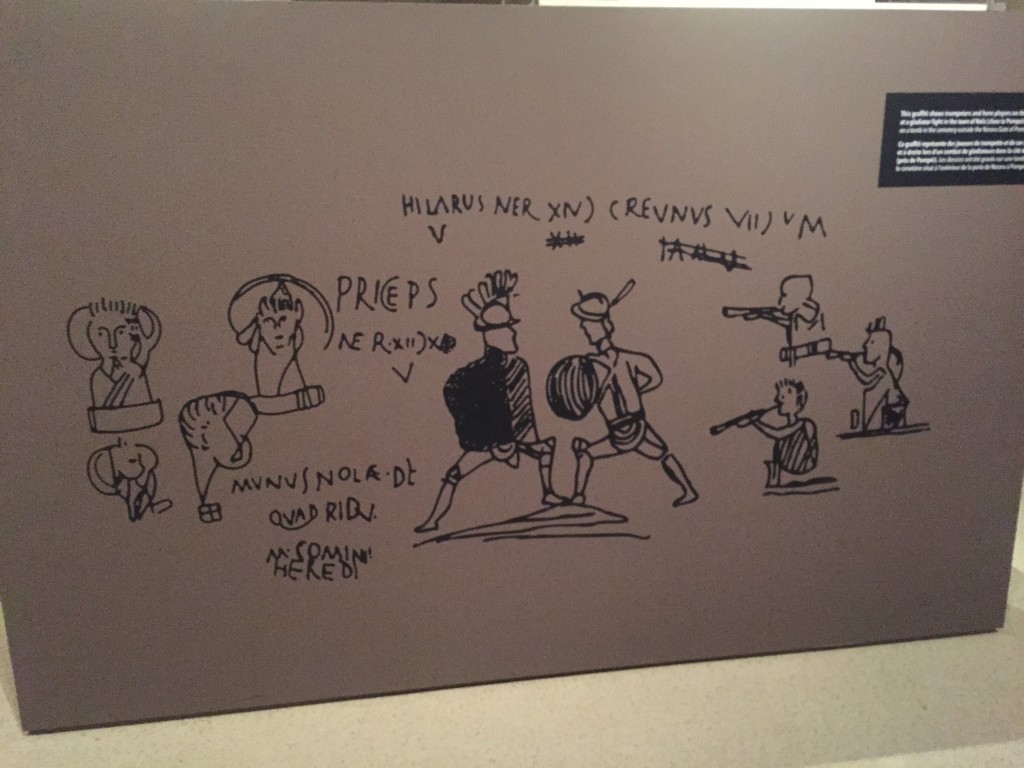So what’s new about humans?
August 17, 2015 by Marguerite Orane
Filed under Featured Posts, Free and Laughing, Observe
 In 1748 a time capsule was discovered when the remains of the Roman city of Pompeii were unearthed. The city had been sealed in a moment of time for almost 2,000 years with the violent eruption of the Mount Vesuvius volcano in AD79. A pyroclastic flow engulfed it and its inhabitants in a matter of seconds, killing all living things and blanketing everything in tons of ash and pumice. Over the millennia, this compacted to preserve the moment perfectly. As the excavation continues, we are able to see what life was really like 2,000 years ago – not by archeologists piecing together bits of shards, but because time stopped, as in a photograph.
In 1748 a time capsule was discovered when the remains of the Roman city of Pompeii were unearthed. The city had been sealed in a moment of time for almost 2,000 years with the violent eruption of the Mount Vesuvius volcano in AD79. A pyroclastic flow engulfed it and its inhabitants in a matter of seconds, killing all living things and blanketing everything in tons of ash and pumice. Over the millennia, this compacted to preserve the moment perfectly. As the excavation continues, we are able to see what life was really like 2,000 years ago – not by archeologists piecing together bits of shards, but because time stopped, as in a photograph.
Surprisingly, as I found out when I visited the Pompeii exhibition at the ROM (Royal Ontario Museum) recently, life then was very similar to life now.
Pompeii was a bustling port city that linked the Roman agricultural hinterlands to far-off lands. There were influences from all around the Mediterranean, in particular Greece and Egypt. The city was prosperous, so support for the arts was magnanimous – sculpture and friezes adorned the beautiful homes of the wealthy, and there were amphitheatres for live performances. A reminder, whether we like it or not, of the importance of wealthy patrons to the arts.
The city was designed with Roman precision, down to the streets with grooves in the pedestrian crosswalks for the wheels of carriages to cross. There was piped running water even in private homes – yes, 2000 years ago!
Politics was alive and well! I smiled when I viewed the wall painting of a wealthy politician handing out bread in exchange for votes. Not much has changed in our politics!
The Roman passion for sport was thriving in Pompeii. There were the inevitable gladiatorial games, when sportsmen literally fought to the death. Depictions of brawls between fans labelled “Hooliganism is nothing new” brought to mind clashes of fans in English football.
Lest we think that “debauchery’ is something new, in Pompeii sex was alive and well. Friezes depicted the god Priapus and his huge phallus, threesomes in bathhouses and even bestiality. Good to remember the next time we bemoan the wild ways of the youth of today! And by the way – a large phallus was a sign of prosperity, so they were liberally depicted at the entrances to homes.
But the biggest reminder of how humans are still very much the same, was the graffiti discovered on tombstones in the cemetery. Turns out, graffiti is not some new art form of rebellious youth – it was alive and well in AD79.
As we ponder on the progress of humankind over the past 2000 years, this exhibit is a stark reminder of the advanced civilization that existed then and earlier. We think we have come a far way, but maybe we haven’t come that far after all. There is so much that we don’t know, so much yet to learn about our tiny planet and its brief history and the even briefer history of man. Good to keep an open, curious mind – to observe, question, learn.
Similar posts by Marguerite:




Hi Marguerite. Your observation really caught my attention. We think we today are so sophisticated with our smartphones and technology when in truth you pointed that although things have changed much in 2000 years, a lot is still the same. I guess that’s where that saying comes from. Much to ponder…
Thank you Chris. It really struck me how sophisticated and developed the Pompeiians were. Only downfall was their failure to heed the warnings from Vesuvius – although some citizens did. Come to think of it, even that behaviour is still prevalent today, despite having technology that gives us more precise and up to date information!
Blessings in abundance
Marguerite